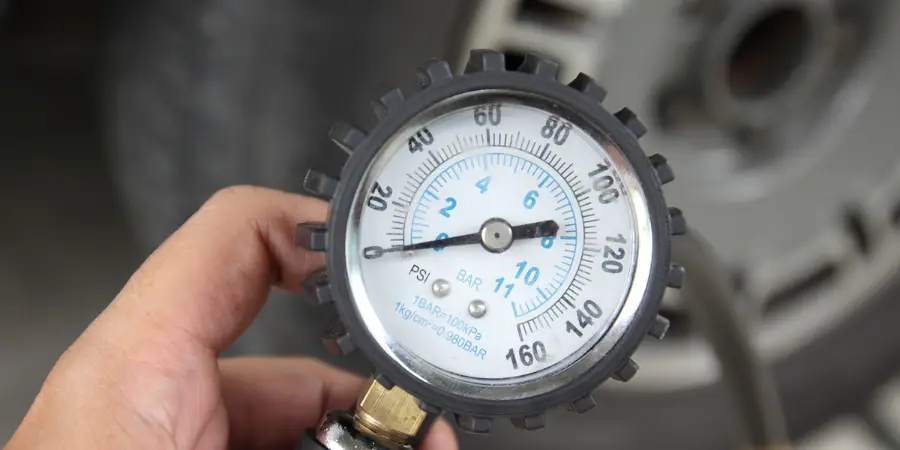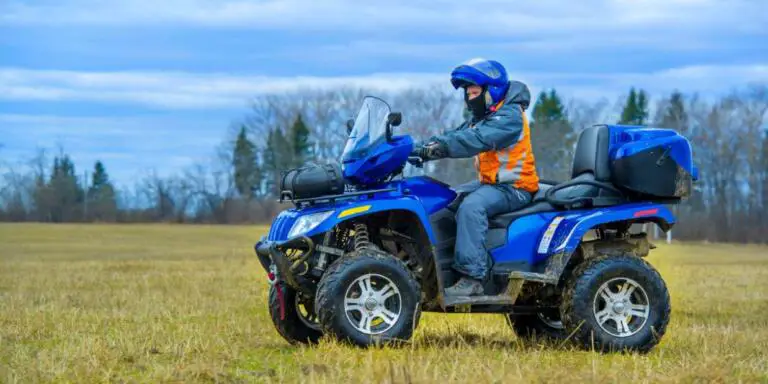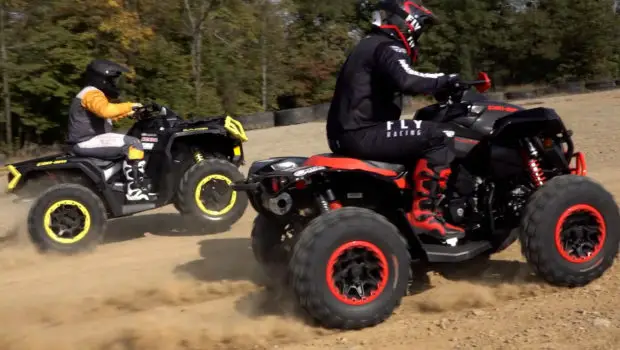ATV Tire Pressure Recommendation A to Z 2023
| Tire Pressure | Conditions |
|---|---|
| 3-4 psi | Soft or loose terrain, such as sand or mud |
| 5-6 psi | Average terrain |
| 7-8 psi | Hard or rocky terrain |
| 9-10 psi | Carrying extra weight |
| 11-12 psi | Riding at high speeds |
The recommended ATV tire pressure varies based on the results you want to achieve and has a direct bearing on the quality and performance of your ride.
We choose to discuss with you all of my recommendations for determining the ideal tire pressure for your ATV because this is a subject that is frequently disregarded.
By standard rule, ATV tire pressure should typically range from 2 to 10 pounds per square inch (PSI).
Since the majority of manufacturers recommend a range of 4 to 7 pounds per square inch (PSI) for ATV tire pressure, you shouldn’t always reach these limits. Any pressure reading below 2 PSI and any pressure reading exceeding 10 PSI run the risk of your ATV tire blowing out.
When you need more traction, like sand or rock crawling, you desire lower ATV tire pressure than the advised value.
However, for towing a load or traveling on a smooth surface, higher ATV tire pressure is preferable.
When choosing the right tire pressure for the day, there are a few things to consider. While 3 pounds per square inch (PSI) seems appropriate today, you may be riding at 8 pounds per square inch (PSI) tomorrow.
Read on to get my complete recommendation on determining the right ATV tire pressure for you, including how to adjust it according to your particular situation.
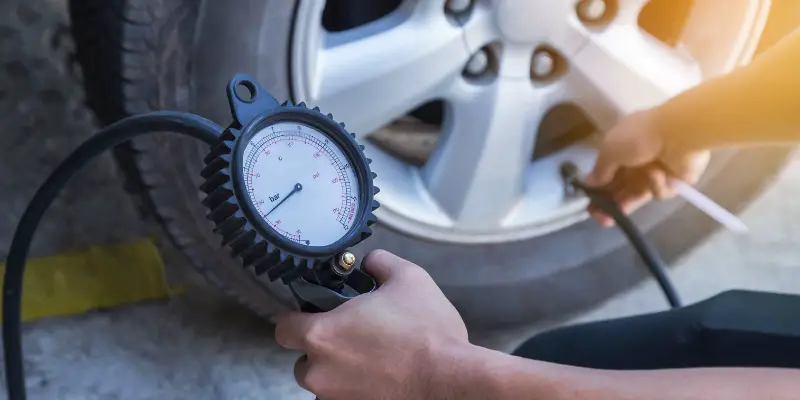
What amount of Air should be in an ATV tire?
Tire pressure for ATVs should be lower than for a UTV or a car, with most users favoring a range of 4 to 7 pounds per square inch (PSI). Checking recommendations is the most straightforward approach to figuring out how much air to put into your ATV tires.
If you opt to replace your factory tires with a different set, you should first check the side of the tires. Check all tires thoroughly because some ATVs have different-sized tires on the rear and front of the 4-wheeler.
You’ll see a high figure, typically between 25 and 30 pounds per square inch (PSI). This is the maximum pressure your tires are permitted to be inflated to; thus, you should never reach this level.
Only use this while mounting your tires for the first time. Depending on your needs, you will then deflate them to a pressure between 2 and 10 pounds per square inch (PSI).
The owner’s manual for your ATV contains the second tip you need to consider. Each ATV manufacturer has its own design, and factors like the ATV’s overall dimensions and weight may affect the recommended ATV air pressure.
As a result, the appropriate ATV pressure might range anywhere from 3 to 7 pounds per square inch (PSI), depending on your particular ATV type.
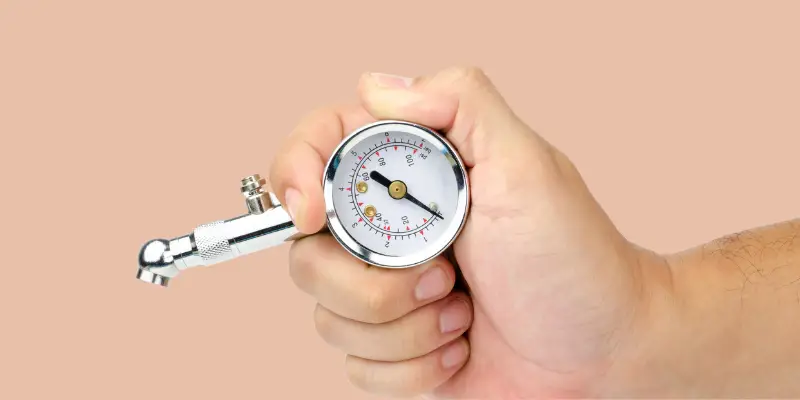
At what PSI level should ATV tires be?
ATV tires should typically have a pounds per square inch (PSI) of 5. 5 pounds per square inch (PSI) is a midrange amount seen as suitable for most situations and is recommended for ATVs by the majority of manufacturers. That does not necessarily mean it is the best option, though.
The right course of action, if you’re looking for a straightforward response, is to maintain the recommended ATV tire pressure listed in your ATV manual. The engineers took into account the typical use of an ATV when deciding on that figure.
If you maintain your pounds per square inch (PSI) between 3 and 7 pounds per square inch (PSI), in line with the specifications of your ATV, you won’t become trapped on a trail.
Having said that, there are advantages to maintaining higher or lower tire pressure. In order to get the best ride possible under various conditions, you must adjust your pounds per square inch (PSI) accordingly.
When You Should Use Lower Pounds Per Square Inch (PSI)
Lower tire pressure on your ATV translates into a better grip for the vehicle on difficult terrain. Heavy mud, snowy trails, and sand dunes all call for lower pounds per square inch (PSI) than normal.
Lowering your ATV tire pressure will improve flotation, preventing you from becoming stuck in muddy areas.
When rock crawling, low tire pressure is another thing you want to have. It takes many modifications and skills, like lower tire pressure, so it is not suitable for everyone. Competitors go so far as to purchase low-pressure tires that are unique and made for this all-terrain experience.
Relative to the manufacturer’s recommendations, it is advisable to stick with a pressure between 2.5 and 4 pounds per square inch (PSI) in all of these scenarios. If you typically pump your tires to 8 pounds per square inch (PSI), a low amount like 2.5 might be insufficient for the weight of your AVT.
In this situation, lowering the pressure by up to 4 pounds per square inch (PSI) should be sufficient to provide you with the traction you want.
When You Should Use Higher Pounds Per Square Inch (PSI)
If you’re planning to ride on a smooth road or if your ATV will be carrying more weight, you should inflate the tires to higher pounds per square inch (PSI). While more pressure will enable faster speeds, it does not cushion impacts as well.
On rocky trails, a high tire pressure puts your quad at risk for damage more readily; thus, flat pavement is where it is most advised.
You may have already noticed that your owner’s manual recommends a higher pound per square inch (PSI) for towing cargo. This is a voluntary disclosure that is often made for utility ATVs.
But that does not prohibit you from increasing your pressure by two or a pound to achieve the same benefits.
You can raise your PSI for a smoother ride, whether towing big items or adding a passenger to your quad.
Depending on the pressure you are currently using, we recommend increasing it to a value between 7 and 10 pounds per square inch (PSI).
Similar to the argument I made in the last section, increasing your tire pressure from 4 to 10 pounds per square inch (PSI) might be too much for your vehicle.
What Should ATV Tires Be Torqued To?
ATV tires are typically torqued to around 15 to 30 foot pounds (lbs-ft) of torque, but it’s essential to refer to your owner’s manual for the specific recommended torque for your ATV.
The recommended torque specification for ATV (All-Terrain Vehicle) tires can vary depending on the specific make and model of your ATV, as well as the type and size of the tires.
It’s essential to refer to the owner’s manual or contact the manufacturer for the precise torque specifications for your ATV. However, here are some general guidelines:
- Owner’s Manual: Always check your ATV’s owner’s manual for the manufacturer’s recommended torque specifications. This is the most accurate and reliable source of information for your specific ATV.
- Lug Nuts/Bolts: If your ATV uses lug nuts or bolts to secure the tires, torque them to the specifications provided in the manual. This typically ranges from 15 to 30 foot pounds of torque.
- Beadlock Wheels: If your ATV has beadlock wheels (wheels with a ring that clamps the tire bead), follow the manufacturer’s recommendations for torque on the beadlock ring bolts. These can often be higher than standard lug nuts, so refer to the manual.
- Tire Size: Larger or more heavy-duty tires may require higher torque values to ensure they are securely fastened. Smaller tires may require lower torque values. Again, consult your manual.
- Tread Pattern: If you have specialized tires with unique tread patterns, the manufacturer might recommend specific torque settings to ensure the tire is properly seated.
- Use a Torque Wrench: To achieve the correct torque, it’s essential to use a torque wrench. This tool helps you apply the right amount of force without over-tightening or under-tightening the lug nuts or bolts.
- Tighten in a Star Pattern: When tightening the lug nuts or bolts, follow a star or crisscross pattern rather than tightening them in a circular fashion. This helps distribute the pressure evenly and ensures proper seating of the tire.
Using the correct torque specifications and technique is crucial to prevent over-tightening, which can damage your ATV’s wheel components, or under-tightening, which can lead to loose tires and safety hazards.
Always prioritize safety and refer to your ATV’s owner’s manual or the manufacturer’s recommendations to determine the appropriate torque for your specific ATV tires.
Wrap-up
We find the topic of ATV tire pressure fascinating because even a minor adjustment can significantly impact your off-roading experience.
While, as a general rule, ATV tire pressure should typically range from 2 to 10 pounds per square inch (PSI), different factors under specific scenarios should be considered when deciding to use lower or higher PSI.

